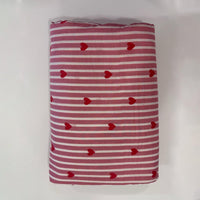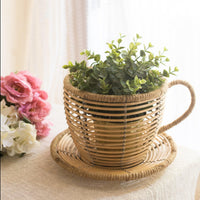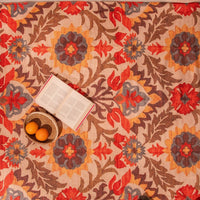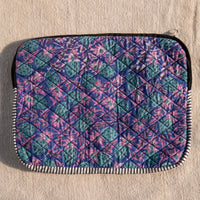How to Clean and Maintain Your Curtains: A Complete Guide
Cleaning and maintaining the curtains gives many advantages. They improve the indoor air quality since they remove all the dust, allergens, and pollutants collected in them. All cleaning is aimed at preventing stains that might result from fading from the sun or the fabrics' discoloration.
Well-kept curtains can extend their lives and improve a room's overall beauty, saving money on renewals. Finally, especially in humid areas, regular maintenance can stop the growth of mould and mildew.
Clean curtains give a home a polished, new look that goes well with the decor, greatly improving the home's aesthetics. All of these reasons combine to make clean curtains an important component of house decor and health.
Different Curtain Types and Fabrics
Blackout curtains: Ideal for media rooms or bedrooms since they are made of thick fabrics that block out light. Provide additional benefits of soundproofing and privacy
Sheer curtains: transparent and lightweight, they offer some privacy while letting light in. Perfect for draping over thicker curtains.
Layered Curtains: For adaptable light control and design, mix & match several fabric kinds (such as sheer and blackout). Allow more personalisation in terms of look and features.
Drapes: thick as well as lined, these offer complete privacy and coverage. Suitable for formal environments and adaptable in terms of styling.
Valances: short drapes that just cover a window's upper part, commonly used to cover up curtain equipment or provide a decorative accent.
Popular Curtain Materials and Tips to Take Care of Them
Cotton is popular because of its breathability and softness. It can be machine washed, making routine cleaning simple; you can also iron it.
Silk is luxurious and smooth; it drapes beautifully but gently. Only dry clean it, and keep it out of direct sunlight so that colours do not fade.
Polyester is resistant to wrinkles, and colours are long-lasting because they dry fast. One can also machine wash, and most of the time it doesn't require ironing.
Linen is airy, naturally textured, and lightweight. It wrinkles easily and can be dry cleaned or hand washed.
Velvet is thick and soft; it absorbs sound and provides protection. It is advised to dry-clean it to get rid of dust.
|
Fabric |
Properties |
Cleaning Methods |
|
Cotton |
Soft Washable Breathable |
Machine Wash Air Dry |
|
Linen |
Lightweight Elegant Easily wrinkles |
Dry clean Hand washed in cold water. |
|
Silk |
Luxurious Delicate Can fade |
Dry clean only Avoid water to prevent damage. |
|
Velvet |
Rich texture Heavy |
Professional cleaning is recommended. |
|
Polyester |
Durable Wrinkle-resistant |
Machine wash Tumble dry. |
|
Sheer |
Light Airy Provides privacy |
Hand wash in cold water Air dry Avoid wringing. |
Importance of Regular Dusting and Vacuuming
Curtains are usually vacuumed and dusted for several reasons. Dust, pollen, pet hair, and other pollutants have made them dirty, which is decreasing the quality of indoor air as well as giving rise to allergy cases. Clean curtains contribute to healthy living spaces.
Dirty or dusty curtains lower the overall appearance of a room. You may improve the beauty of your space by keeping your curtains clean. Routine cleaning prevents the wear and tear caused by trash that has been collected for a long time, extending the life of the fabric. It also helps prevent odors brought about by allergies and dust. Last but not least, keeping an area clean will prevent common insects like dust mites and insects from inhabiting it.
Easy-to-follow Guidelines for Cleaning Curtains
Cleaning curtains the right way means you need to dust and vacuum, each with its own set of tools and methods. First, get your space ready by moving anything that might be in the way. Take a microfiber cloth or a duster and start at the top of the curtains, working your way down to catch all the dust while keeping the fabric safe.
If your curtains are tall, a step stool can help you reach those higher spots easily. Don’t forget to dust both the front and back for a complete clean. One should use it with the brush attachment of a vacuum cleaner because it gently lifts the dust off without tugging on the fabric.
A vacuum cleaner is also a good tool for dusting curtains. It works gently enough to perfectly deal with dirt stuck in the fabric. This technique works great on heavier materials, like velvet or drapes, in order to not pull or tear the texture.
For those hard-to-reach areas where dust tends to collect, a long-handled duster or attaching a microfiber cloth to a broom handle can make for quick fix. Once you've gotten into this routine cleaning, it really does prevent the dust from storing.
Also, closing your curtains when they are not in use prevents dust from settling on them, and an air filter or purifier will help minimize airborne dust. By following these guidelines, you are ensured to have beautiful curtains as well as a fresh living area.
Stain Removal and Spot Cleaning
Food and grease-type stains, as well as sauces, can be usually removed with an all-purpose solution that is mild detergent in warm water.
For stains of food, like sauces or grease, a mild detergent mix with warm water is an all-purpose cleaning agent that can be used. Blot the area lightly using a cloth soaked in this solution, and then rinse off with clean water. For drinks (coffee, wine, etc.), a solution of equal parts white vinegar and water will work well. Dab the spot and then blot dry.
Pet accidents should be treated immediately before smells and discoloration occur. Use an enzyme-based pet stain cleaner because these types of cleaners break down the proteins found in waste. Follow the instructions found on the product label for application and then rinse well.
Dirt spots can be easily taken care of by a mixture of warm water along with a few drops of dish soap. Then brush or wipe the stained area clean while doing it softly. After that, wash it off with water.
Dry Cleaning and Washing
Cleaning the curtain at home gives an added bonus year, but there are maintenance suggestions that should be followed. Wash exposed materials at least once every six to twelve months. Be cautious of chemicals like chlorine, and use gentle detergents.
Hang delicate garments in a net laundry bag to keep them safe. Choose dry cleaners if the care label suggests machine washing or if the cloth is delicate. Dry cleaners keep the condition of the curtains safe by using certain chemicals and techniques.
Additional Tips For Cleaning and Maintaining Your Curtains
How to Deal With Fading and Sun Damage: Maintain the freshness of your curtains and avoid the risk of sun damage. Use UV-resistant fabrics or line them up with materials that block out UV rays, thereby preventing fading.
Adding sheer curtains or blinds would also be a smart move; they let in light while protecting your main curtains from harsh sunlight. Never forget to interchange the curtains sometimes, either by changing their position or by moving them around so that all parts of the fabric get a good share of sunlight.
Control of Mold and Mildew: They can develop easily from curtains left in the room without drying or proper ventilation. Ideally, one should ensure that curtains are washed and, therefore, dried properly before putting them up again.
A dehumidifier may be installed to counter damp spaces. However, if you are staying in a damp climate, consider using mold-resistant fabric or applying spray that helps prevent mold and mildew development.
Take Care of Your Curtains: Storage and handling are very important if the curtains are to be in top shape. Ensure that they are clean and perfectly dry when you will be putting them away to avoid any mold. You should use a breathable bag or container to prevent dust and pests.
When putting them away, do it gently without pulling or stretching them. Let them hang to dry completely, or fold them if you would like to take them down for cleaning or storage. Folding is a better option because hanging can crease or damage them.
Conclusion
The freshening of your house will come when you have your curtains clean. In fact, cleaning the curtains is the best way to remove dust, allergies, and other diseases that are carried along within the atmosphere.
This gives the curtains a fresh new look, and it also improves the quality of air in your house. Maintenance of curtains increases their lives. This can be done through proper vacuuming and washing, depending on the type of fabric they are made of. A decent time to dwell on maintaining clean curtains is a symbol of ensuring that one has a healthy and comfortable living space.




























Leave a comment